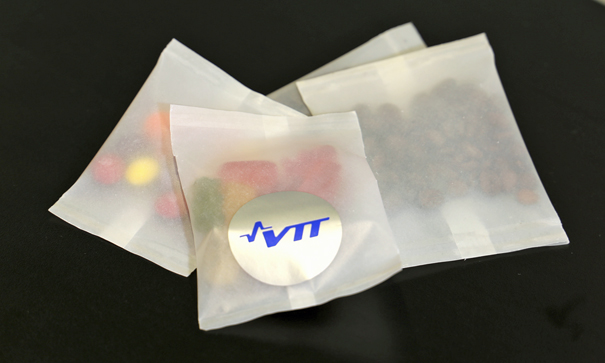Ellen MacArthur Foundation Awards VTT for Bio-based Packaging Solution
![]() Print this Article | Send to Colleague
Print this Article | Send to Colleague
The Ellen MacArthur Foundation (U.K.) has awarded VTT Technical Research Centre of Finland for a packaging solution made of cellulose in Davos on Jan. 23, 2018. VTT is one of the five prize winners, between whom the foundation splits a one-million-dollar prize in equal shares. The new material can extend the shelf life of food, while also reducing food waste and the worldwide microplastics problem.
As material, cellulose is safe, renewable, recyclable, and compostable. VTT developed a compostable and lightweight packaging material by combining cellulose films with different, but complementary properties.
The plastic-like packaging material is suitable for dry and greasy products, such as nuts, cereals, coffee, condiments, and raisins. The greatest benefits can be reached when the material is used for packaging products with a long shelf life.

In terms of properties, the material is highly competitive or in many cases even better than the currently available biodegradable bioplastics. With minor modifications, it can be produced with existing production machinery.
The packaging can be produced by combining cellulose films with different properties. The flexible and transparent lightweight material protects the product from atmospheric gases and humidity. It also forms a barrier against the grease or mineral oil in the product. The package can be sealed by heating.
"By optimizing the layer structure, we can improve the technical properties and reduce the amount of materials used. If the package was manufactured of one cellulose-based material only that would meet all the requirements for a good packaging material, the package would be very thick and heavy," said Ali Harlin, research professor at VTT. He estimates that the packaging material can be commercialized within three to five years.
In commercialization phase, the amount of packaging being produced will affect the price of the material. The use of material must be economically feasible with a view to the whole product.
On Aug. 15, 2017, the Ellen MacArthur Foundation announced a prize aimed at seeking new materials to solve the global microplastics problem. The matter is urgent: it has been estimated that every year more than 8 million metric tons of plastic waste ends up in oceans. The million-dollar prize awarded in Davos on Jan. 23, 2018, is shared equally between the following operators and teams: VTT, the University of Pittsburgh, Aronax Technologies, Fraunhofer Institute for Silicate Research, as well as the Full Cycle Bioplastics, Elk Packaging, and Associated Labels and Packaging team.
All winners are part of a 12-month New Plastic Economy Accelerator Program, where they are provided expert support to make their innovations marketable. When one year has passed, the Foundation will award an additional million-dollar prize to the best contestant.
"In a New Plastics Economy, plastics will never become waste or enter the ocean in the first place. To get there will require new levels of commitment and collaboration from industry, governments, designers, and startups. I hope these innovations will inspire even more progress, helping to build a system in which all plastic materials are reused, recycled, or safely composted," says Dame Ellen MacArthur in a press release on Jan. 23, 2018.
The Ellen MacArthur Foundation is a British foundation, founded in 2010 by Dame Ellen MacArthur, who became famous as a sailing competitor. The purpose of the foundation is to accelerate the transition to a circular economy. More information is available online.


